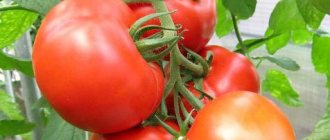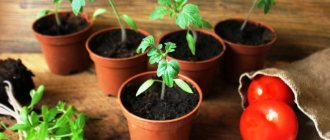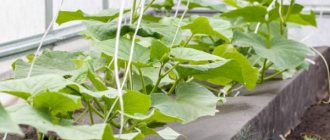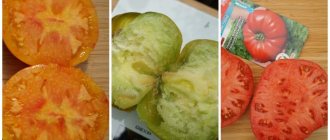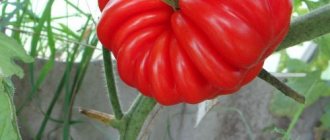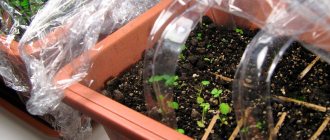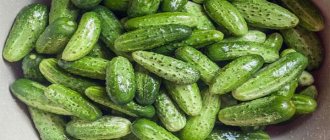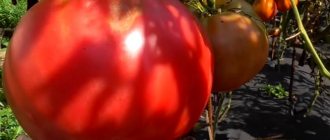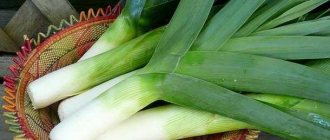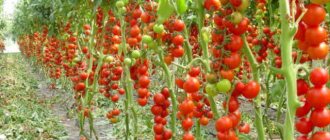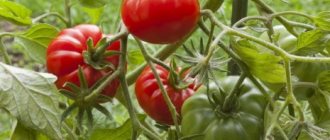Dates for planting tomatoes as seedlings for the Moscow region
Tomato varieties zoned for the Moscow region usually begin to be sown for seedlings from the end of February until almost the first days of April. This range of dates is due to the characteristics of the variety and the method of cultivation. Tomatoes with medium and long growing seasons intended for cultivation in greenhouses are planted earlier. Varieties with short ripening periods can be successfully grown without shelter in the conditions of the Moscow region. But it is precisely for them that planting dates must be strictly observed, taking into account the agroclimatic conditions of a particular territory.
Tomato variety Sweet Bunch
It is characterized by the shortest ripening period. The fruits can be collected 85-90 after planting the seedlings. This is an exclusively greenhouse tomato variety. Up to 50 small fruits weighing about 40 g are formed on one shoot brush. Shoots can grow up to two meters in height.
In this regard, it is necessary to create garter structures for it. Characterized by resistance to a wide variety of ailments.
Climatic features of the region
In the very large area of Moscow and the adjacent Moscow region, in conditions of a temperate continental climate, there is a spread of above-zero temperatures. The duration of frost-free periods varies significantly.
If the average for the region is considered to be 120-125 days, then in the Naro-Fominsk region this period, according to statistics, is only 102 days. This is due not only to the geographical location of the garden or personal plot, but also to the terrain features and elevation changes.
When planning to grow tomatoes outdoors, you need to determine the period when you can plant seedlings without fear of return frosts. For different zones of the Moscow region, the transition of average daily air temperatures into the spring, through the 10-degree mark, occurs at different times.
For the north and center of the region, it falls on May 8-10, and for the southeastern regions, the transition takes place a week earlier.
In most areas, steady warming begins only from May 11-13. In areas with flat terrain, periods of frost stop on May 10-20, but in some years the return of frost can be expected even in the first ten days of June.
Therefore, we can only talk about conditional planting dates, which each gardener must adjust to suit himself. Knowing the characteristics of our site, we take the period of possible return cold snaps as the basis for calculations. They are the main obstacle to transplanting tomatoes into open ground in the Moscow region in early spring.
Agrotechnical techniques for preparing seeds and caring for seedlings largely influence their full development and can increase or shorten the period from planting to harvest.
Preparing the land for planting
Before growing tomatoes, you need to think about the quality of the soil. Its preparation should begin in the fall. To do this, carry out the following steps:
- you need to free the land from old tops and grass;
- the cleaned soil should be sprinkled with Bordeaux mixture;
- We move on to fertilizing the soil, for this we add potassium chloride and superphosphate to the soil in a volume of 60 grams per square meter of soil;
- We dig up the soil before winter to a depth of 30-35 cm.
This is how we prepared the soil on the site for the new planting of tomatoes. But before that, we have to prepare seeds and grow seedlings. It’s worth telling about everything in order.
Calculating the timing for sowing seeds
Having determined the number from which tomato seedlings can be transplanted into open ground, we study the recommendations of the seed manufacturer. Usually, descriptions of a variety always indicate the age that the seedlings should have at the time of transplantation to a permanent place. This figure for different tomatoes can vary from 45 to 65 days, and is counted from the moment of emergence.
To this period should be added 4-7 days for the germination period itself, and an adjustment of up to 5-7 days for survival after picking. We count the resulting number of days on the calendar in the opposite direction and get the date when to plant tomatoes for seedlings.
- Late-ripening varieties of tomatoes, for which a greenhouse will be a permanent place of growth from the beginning of May, are sown for seedlings at the end of February, beginning of March.
- Traditionally, for varieties with medium ripening periods that are planned to be planted in open ground or under light film covers, the seeds are sown in the third decade of May, early June, in late March, early April.
- Determinate or dwarf early varieties, which are planted in the ground on June 5-10, are sown for seedlings in early April. If they are planned to be protected from frost by light shelters, then the planting date is postponed to an earlier period, in the third decade of March.
Important! By transplanting hardened tomatoes into open ground at an early stage, you can achieve intensive growth of the root system.
Earlier sowing dates are not always justified, because plants are very demanding on lighting. If there is a lack of sunlight, temperature control or additional lighting will be required. The methods of hardening seeds and seedlings also have an important role on the behavior of plants.
By changing watering regimes and carefully monitoring the condition of the seedlings, it is also possible to cultivate vegetative or generative tendencies in the plant and thereby influence the duration of the seedling period.
Zoned varieties for greenhouses in the Moscow region
In closed ground there is a chance to get a record harvest. The varieties chosen for greenhouse cultivation are:
- indeterminate;
- little susceptible to disease;
- with long and abundant fruiting.
Salad tomatoes
Tomatoes for fresh eating take longer to gain weight and ripen, but are superior in taste to pickled varieties.
Mikado pink
Some tomatoes, just appearing on the market, immediately win many fans. The mid-early salad variety Mikado pink is a leader in greenhouse farms in central Russia. The plant is indeterminate, medium leafy. The color of ripe flat-round tomatoes is pink. The fruits gain a weight of 300–360 g. With proper care, up to 6 kg of crop can be harvested from 1 m2.
The Mikado pink tomato variety is popular due to its taste and yield.
Golden Nugget
New tomato varieties inspire with color and yield. The early ripening variety Golden Nugget with orange elliptical fruits was developed in agriculture. The plant is limited in growth, but prolific: up to 9 kg of tomatoes per 1 m2. Fruit weight - 90–130 g. Children like bright tomatoes.
The Golden Nugget tomato variety produces a yield of up to 9 kg per square meter
Pink honey
Usually, sweet tomatoes are selected for salad. The mid-season variety Pink honey has an excellent sugar taste. It was bred for greenhouses, but experienced summer residents also cultivate it in open ground. The determinate plant produces pink ribbed fruits weighing 160–200 g. The maximum yield is 3.8 kg per 1 m2. The bush needs a garter.
The Pink Honey variety has a modest yield, but good taste
Tolstoy F1
Hybrids with complex resistance to diseases are popular in the Moscow region. The Tolstoy F1 variety is not affected by tobacco mosaic virus, verticillium blight, cladosporiosis and fusarium blight. This sweet, small-fruited tomato for sandwiches and salads produces red fruits weighing 79–124 g. The yield of Tolstoy F1 reaches 5.7 kg per 1 m2.
Variety Tolstoy F1 - an unpretentious Dutch hybrid
Pink raisins
Yield tomatoes are reconciled with the cost of purchasing a greenhouse. The variety of Ukrainian selection Pink raisins is characterized by summer residents as a miracle tomato. Complex fruit clusters are formed on the bushes, on which there are 20 or more red-pink creams weighing 60–130 g. The fruits do not crack when watering is interrupted, they lie well and are transported. Up to 5 kg of tomatoes are harvested from one plant.
Pink raisin tomato is suitable for both fresh eating and pickling
Cherry tomatoes
Small-fruited cocktail tomatoes are best grown in a greenhouse, since their fruiting is extended over time.
Sweet bunch
Sweet cherry tomatoes with dense pulp are highly valued by gardeners in the Moscow region, since such tomatoes are also suitable for harvesting for the winter. The early-ripening variety Sweet Bunch forms large complex clusters with red fruits weighing 20–30 g. The plant is distinguished by large dark green leaves. The variety is indeterminate and requires support and pinching. In a greenhouse, 3.5 kg is removed from 1 m2.
Tomato variety Sweet bunch bears fruit for a long time and abundantly
Magic harp
Hybrid varieties for greenhouses are productive and suffer less disease. Variety Magic Harp F1 produces beautiful clusters with orange fruits weighing 20–25 g. It ripens early and has unlimited growth. Does not suffer from fusarium and viruses. From 1 m2, a persistent summer resident manages to collect up to 5.7 kg of marketable fruit.
Tomatoes Magic Harp F1 are yellow at the beginning of ripening, then turn orange
Black chocolate
When decorating dishes, cherry tomatoes of all colors of the rainbow are useful. The Dark Chocolate variety is distinguished by its rare fruit color - violet-brown. The tomato is indeterminate and requires pruning of shoots and support. The fruits weigh about 25 g. The yield per 1 m2 is 4.7 kg.
More than ten fruits can ripen on a bunch of Dark Chocolate tomato
There are a lot of varieties of tomatoes for the greenhouse; you need to choose the ones that are suitable for ripening, type and size of the fruit.
Video: the best varieties of greenhouse tomatoes for the Moscow region
Checking the dates of the Lunar calendar
Many gardeners find a rational grain, guided by the Lunar calendar during the periods of growing seedlings. You can trust or ignore such techniques, or you can familiarize yourself with and adopt other people’s experience.
If we take into account the influence of astronomical rules, then tomatoes are planted and picked only during periods of the waxing Moon. In the Moscow region, the timing of sowing tomatoes for seedlings falls on the following dates:
- February 16, 17, 18, 21, 22, 25, 26;
- March 20, 21, 24, 25, 26;
- April 17,18, 21,22, 27, 28;
- May 18, 19, 24, 25, 26;
- June 14, 15, 21, 22.
These dates in 2021 will help gardeners navigate and observe the effect attributed to the Earth's satellite. If you have a calendar at hand, you can track favorable dates for agricultural work.
During the moments of the full moon and new moon, any actions with plants, especially planting tomatoes, are not recommended.
Hardening of seeds shortens the seedling development period of tomatoes by 5-7 days, affects yield and earlier ripening of fruits.
Varieties that do not suffer from late blight
Well, in conclusion, I would like to give the best seeds for growing tomatoes, which are least susceptible to late blight.
In general, late blight is the most dangerous disease to which tomatoes of various varieties are susceptible. This disease appears due to high humidity in the atmosphere or due to strong changes in air temperature.
Therefore, it is best to choose hybrid seeds; they are least susceptible to this disease. Since I myself am new to this topic, I found some useful information for you, read it and write your comments.
Even in our time, tomatoes such as cherry tomatoes have become popular. These are small tomatoes that can be grown on balconies and window sills, and with special care, in greenhouses.
In the Moscow region you can consider the following types of cherry tomatoes:
Features of planting seeds for seedlings
Often, gardeners make the mistake of trying to plant tomatoes as early as possible. This leads to overgrowth of seedlings, which often suffer from a lack of adequate lighting. Therefore, it is better to sow a tomato within the estimated time frame, but try to create conditions for the plant that will allow it to grow stronger and endure replanting in open ground. There are simple techniques that prepare the plant for stressful situations.
One of them is pre-sowing seed preparation:
- seed disinfection is carried out in a 1% manganese solution;
- The seeds are soaked in a growth stimulant or clean water for 12 hours;
- at the next stage, for hardening, they are kept for 7 days at zero degrees in the refrigerator;
- we sow the seeds only in well-fertilized and moistened soil, deepening them by 1.5-2 cm;
- germination temperature for cold-resistant varieties starts from 8 degrees, but the best results correspond to 22-25 degrees;
- to speed up germination, it is recommended to mulch tomatoes with transparent film;
- with the emergence of seedlings, the film is removed and placed in an area with good lighting, while observing the intended temperature regime.
If these rules are followed, tomatoes demonstrate a reduction in growth time to 7 days and an increase in yield by 30%.
Also, the further development of the plant is influenced by the quality of care and compliance with agrotechnical practices. Growing seedlings involves watering and proper nutrition. Clear regulation of temperature and humidity, adequate lighting. A couple of weeks before transplanting into the ground, the plants begin to get accustomed to low temperatures and sunlight.
Properly prepared seedlings will spend much less time adapting. Planting in open ground will not be painfully stressful for her. According to experts, even cold-resistant varieties can be too pampered at home, which will certainly affect the timing and yield of tomatoes. Therefore, the question of when to sow seeds for seedlings will require more than just general advice. It is necessary to collect data on the agroclimatic characteristics of your site and make simple calculations based on them.
When and how do I plant tomatoes in the ground in the Moscow region?
In my garden in the northern Moscow region, I plant seedlings in open ground from May 20 to 25. I prepare the bed in advance and provide shelter immediately after planting. I choose proven low-growing varieties, adapted for open ground. Read all the details of planting in the article and watch in my video.
What varieties of tomatoes do I plant in open ground?
I plant low-growing varieties of tomatoes for open ground in the beds:
How I prepare a bed for tomatoes in the open ground
To a 4 m long bed I add:
- 1 bucket of compost,
- 1/2 bucket of ash (plus I sprinkle a handful of ash in each hole),
- superphosphate,
- complex mineral fertilizer.
I pre-watered the bed with phytosporin to prevent late blight. I covered the bed with film so that the soil would warm up and get closer to the temperature in which the tomato seedlings had been growing for a long time. _____________________________________________________
How I plant tomato seedlings in open ground
I first pinch off the cotyledon leaves, and on some bushes the first true leaves, so that the leaves do not touch the ground after planting. I add a handful of sol and a pinch of hydrogel to the hole.
- I take the seedlings out of the cups, immerse the strong, squat bushes vertically into the hole, slightly deepen them and sprinkle them with earth.
- I plant the elongated seedlings at an angle and deepen them. I pinch off the lower leaves in advance. In the hole I place the root system to the south - this is important!
- I water it with a solution of potassium humate (2 tablespoons per 10 liters) and after that I fill it thoroughly with soil.
- In the holes I immediately put a tag with the name of the variety and supports for the garter.
After planting, I make sure to cover it with non-fabric from cold nights, from the wind, and from the hot sun. To do this, I install arcs on the beds, and if there is a threat of frost, I also lay film on top.
Which tomatoes are best to plant?
When selecting seeds for the Moscow region, you need to know exactly which tomatoes are suitable for these weather and climatic conditions.
In open ground, predominantly early-ripening determinate or super-determinate varieties are grown. Preference should be given to varieties developed by local breeders. Seed material is purchased only at trusted locations and from reputable manufacturers. In order not to be left without a harvest due to weather disasters, it is worth planting several varieties with different characteristics. Varieties with early ripening periods have time to yield more crops in a short summer and are less exposed to infectious agents.
Many gardeners and gardeners who want to get a plentiful and high-quality harvest of tomatoes begin to plant tomatoes in greenhouses. But in order for their expectations to be met, you need to know how to do it correctly. If we talk specifically about the Moscow region, then in this region it is recommended to plant tomatoes in early April. Such terms are suitable for greenhouses built from polycarbonate.
You can use both early, quickly ripening varieties and medium ones. In this case, the first ones need to be planted at the beginning of March, and the second ones - after the 10th of April.
Growing tomatoes in greenhouse conditions can be divided into the following stages:
- Preparing the soil for planting - the soil where the tomatoes will grow needs to be fertilized. To do this, you can take humus, turf soil, peat mixture and mix in equal proportions. Then add superphosphate fertilizers, a little sand and wood ash. This mixture is placed in boxes approximately 7-9 cm high and generously moistened on top.
- Planting seeds is an important step. The prepared boxes are brought into the greenhouse and compacted in place by hand, making small strips for the plants. The holes should be no deeper than one and a half to two centimeters, and the optimal interval between seedlings is considered to be 5-7 cm, so that the grown bushes do not clog each other. The seeds are sprinkled with earth on top and compacted a little.
- Next begins the wait for the seeds to germinate.
As for the temperature in the greenhouse at which the seedlings would germinate faster, it ranges from 23 to 25 degrees.
Among the climatic features of the Moscow region are:
- sudden temperature changes in summer from 25 to 10 degrees Celsius;
- increased air humidity, reaching 75-80 percent;
- the beginning of autumn frosts in early October-November.
When buying seeds of tomato varieties for open ground, rely on the following:
- The selection of the type of vegetable is carried out in accordance with the conditions of the site, soil characteristics, and the capabilities of the summer resident.
- It is better to choose a vegetable plant bred by local breeders.
- Purchase tomato seeds from trusted manufacturers.
- Several types of vegetable plants should be planted so that weather conditions during the growing season do not lead to the death of the bushes and leave them without a harvest.
In open ground, both low-growing, determinate species and tall, indeterminate species will develop and bear fruit better. But the time of ripening also plays an important role in obtaining a high-quality harvest.
Of course, any gardener and summer resident dreams of a good and rich harvest, and that all the vegetables he collects have an excellent appearance and taste. Therefore, growing in greenhouses and greenhouses makes it possible to obtain indeterminate, tall and more heat-loving varieties of tomatoes.
But for residents of Moscow and the Moscow region, due to frequent temperature changes, it is very difficult to grow healthy tomatoes. And yet, for our region, varieties have been selected that are excellent for polycarbonate greenhouses and other types of film greenhouses. Such tomatoes, grown indoors, give a very good harvest. And if desired, they can grow in open ground.
Let's take a closer look at the description of the most popular varieties for the Moscow region.
- These tomatoes are hybrids and early ripening. They can be used both in ripe form and for pickling, making juices, and tomato paste. The planting pattern is as follows: 50 by 40 cm, planting density - 7-9 plants per 1 square meter. The ripening period from germination is 72 days. They are considered resistant to various types of diseases. They are bright red in color and flat-round in shape. Care is the same as for ordinary plants: watering, weeding, loosening, fertilizing with mineral fertilizers. Tomatoes have high taste and commercial qualities. Productivity up to 4.5 kg per plant.
Here's what people write about this type of tomato:
- They are universal and early ripening. The harvest is excellent, the bush is ordinary. Height is from 40 to 100 cm, and the raceme is multiple. About 115 days pass from the germination period to the first ripening. The fruit is oval-shaped, red, 40-50 g. by weight. Suitable for growing both in greenhouses and in open ground. They bear fruit until September and are ideal for canning. They have a sweetish taste and are small in size.
Here's what people say:
- It is the most popular type of tomato among gardeners and summer residents. A very unpretentious and productive plant, resistant to diseases. It is considered short and rarely exceeds 60 cm in height. The fruits ripen 3 months after the first shoots appear. They have a round shape with fleshy pulp and excellent taste. Tomatoes are suitable for eating and canning.
Setting the stage
The best thing is to prepare the soil for planting in the fall. It must be well dug up and fertilized. And then before planting, all that remains is to slightly loosen and level it.
The bed should be located in a sunny place, protected from the wind. It is advisable that the tomato planting site be illuminated by the sun all day.
Tomatoes love light soils, and, as experienced gardeners advise, it is best to plant them in ridges or high beds. This ensures good soil heating and optimal air conditions for the root system.
IMPORTANT! You cannot plant tomatoes in beds where fresh manure has been applied.
Let's start landing
The seedless method is not suitable for this region, so if you want to eat your own tomatoes, then get ready to grow seedlings.
When to plant tomatoes in the ground in the Moscow region?
The main indicator here will be the soil temperature, since tomatoes need it to warm up to a temperature of 14-16⁰C.
Much depends on the characteristics of a particular year (early or late spring, precipitation, whether return frosts are expected), but usually this time is the first or second ten days of May.
IMPORTANT! Try to plant tomatoes not all at once, but in groups, with a short break between plantings of 5-7 days.
When growing seedlings in separate containers (pots, cups), special preparation for transplantation is not required.
If the tomatoes were planted in boxes, it is problematic to preserve a lump of earth on the roots when transplanting. In this case, it is recommended to use a special mash for better seedling survival.
It’s good if the day you set for landing is cloudy. Tomatoes take root better; they will not be fried by the bright and burning spring sun. If this does not work out, then it is advisable to first cover the planted plants from the rays of the sun.
Make holes in the soil (up to 12 cm deep), add humus and compost, add superphosphate well, then water generously.
The tomatoes, along with the soil on the root system, are carefully lowered into the hole and buried down to the first leaves.
City dwellers often overgrow their tomato seedlings in the Moscow region; due to the lack of light in their apartments, the plants stretch out. But a tomato is a specific plant; its roots grow along the entire length of the stem, which is in the ground. And this is where it’s good to use this feature of tomatoes.
- If tomato plants are up to 40 cm in height, they are planted directly in the holes.
- If the height is greater, the seedlings have outgrown, then it is advisable to plant them obliquely, at an angle of approximately 40-45⁰. This technique is used to ensure that the plants produce additional roots, which will increase the supply of nutrition to the tomatoes. If overgrown seedlings are planted strictly vertically, and even in open ground, then there is a risk that the plants may be broken or damaged.
The choice of distance between tomatoes is dictated by the characteristics of the varieties.
- Between low-growing tomatoes, 35 cm is enough;
- Between medium-sized and tall, the distance should be at least 50 cm.
How to plant depends on the location of the site or bed. Some people like to plant in rows, others prefer a checkerboard pattern.
If everything is done correctly, then after 5-7 days the tomatoes will already take root and begin to grow.
Caring for tomatoes when grown in open ground
Having achieved the first victory, when your seedlings have taken root, we continue our work further. Basic agricultural techniques:
- loosening;
- hilling and mulching;
- removal of shoots and leaves on plants;
- watering;
- garter of tomato plants;
- fertilizing
Loosening
Loosening is very important, since it helps to remove the crust that forms on the soil surface after watering or rain.
This allows for normal gas exchange, eliminates instant evaporation of moisture, and prevents the occurrence of fungal diseases.
Picking tomatoes
The timing of tomato harvesting depends on the variety, the characteristics of the region, and proper agricultural technology.
It is clear that there are more productive years and less productive years, but still hard-working gardeners manage to get good harvests even under unfavorable conditions.
The main harvest occurs in July-August.
Speaking in numbers, in early varieties it takes about 45-50 days from fruit set to ripening.
Usually ripe tomatoes are picked, as well as slightly unripe ones, which are sent for ripening.
This allows you to avoid infection of fruits with late blight, which likes to “appear” in August, when the main heat subsides and cold dew appears.
Covering plants with non-woven materials gives a good effect, but if this is not possible, then it is better to remove the fruits (even green ones).
Some tips for gardeners
The climate of the Moscow region is not particularly favorable for growing tomatoes in open ground. And it is necessary to follow certain rules that will allow you to get a good result.
- Choose early varieties suitable for growing in open ground and resistant to late blight.
- Use nonwoven materials as shelters (there is a very large selection of them on sale).
- Avoid dense plantings of plants, planting them exactly according to the scheme. It would be better if there were fewer tomatoes per square meter, but they would be provided with nutrition.
- In August, you should reduce watering, monitor the condition of the soil, and avoid waterlogging.
- When harvesting, remove brown and large green tomatoes along with ripe red tomatoes so that they ripen at home.
Primary preparation for growing seedlings
It is important to properly prepare the soil and boxes. Before planting, the latter are washed well with water and treated with a blowtorch, killing all pathogenic bacteria. Peat or clay pots and plastic cups are also suitable for growing seedlings. They should simply be washed thoroughly in warm water. Two weeks before sowing the seeds, all boxes are filled with soil and kept in a warm place. Immediately 1-2 days before, the soil should be shed with a weak solution of potassium permanganate, that is, potassium permanganate, in a ratio of 10 grams of the substance per 10 liters of water.
Which varieties do you prefer?
Of course, every gardener tries to find the best varieties and seeds of tomatoes for open ground in the Moscow region. Today there is a large choice, many summer residents praise different varieties, because a lot depends on personal preferences and requests. Here is a list of those that have proven themselves well and are popular:
- Sultan F1 is a Dutch hybrid, short. It has good yield and resistance to temperature changes.
- Batyanya is an excellent high-yielding variety for open ground. Harvested tomatoes are stored for a long time.
- Honey Drop is a tall variety, the fruits are bright yellow, small, and resemble a drop.
- Severyuga is a large-fruited variety, unpretentious and productive.
- Demidov is a variety that is distinguished by high resistance to late blight. The plant is small, compact; up to 6-7 bushes can be grown on one square meter.
- Beach cherry is a productive, unpretentious variety.
Sources:
https://dachamechty.ru/tomat/sroki-poseva-na-rassadu-dlya-podmoskovya.html https://antonovsad.ru/kogda-i-kak-ya-vysazhivayu-tomaty-v-grunt-v-podmoskova -2851/ https://sait-pro-dachu.ru/rekomendacii-ogorodnikam-kogda-v-podmoskove-vysazhivat-v-grunt-pomidory/
